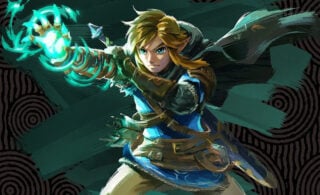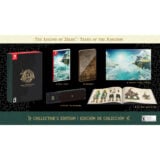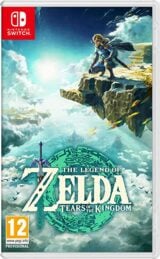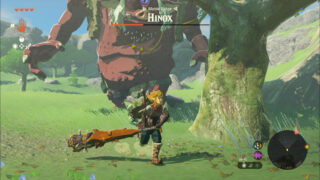Review: Zelda: Tears of the Kingdom lets your imagination run wild
But like its shattered Master Sword, Nintendo’s big sequel is a flawed masterpiece
- Game Director
- Hidemaro Fujibayashi
- Key Credits
- Eiji Aonuma (Producer), Satoru Takizawa (Art director), Takuhiro Dohta (Technical director)

There are moments during Tears of the Kingdom where I wondered aloud if it were the best game I’d ever played.
A confluence of incredible new mechanics, over-achieving visuals, and best-in-class music come together in such harmony that you feel like you’re playing the apex of the medium. They can’t have done it again, can they? Well, yes and no.
Let’s establish this early: The Legend of Zelda Tears of the Kingdom is easily one of the very best games on Nintendo Switch. We say that because it’s important to establish the game’s overall level of quality before discussing some of the frustrations that are left in the game in pursuit of another genre re-definer.
Tears of the Kingdom was first unveiled as “The sequel to Breath of the Wild”, and in some ways, that feels like a better title for the game than the one it ended up with. We’re exploring the same Hyrule, an old friend to greet us as we come to grips with the fundamental changes to Link’s arsenal. Zelda’s gone, a mysterious sludge is perforating every corner of the world, and Link’s the only one who can save the world, again.

However this time he won’t do it with his magical Wii U tablet from Breath of the Wild, instead he’s equipped with a magical Nintendo Switch, the key to Link’s new suite of abilities that make Tears of the Kingdom sing. The Ultrahand, Fuse, Ascend, and Recall abilities in unison turn Tears of the Kingdom from a game that somewhat too often flirts with being a retread of Breath of the Wild, and elevates into some truly spectacular.
Ultrahand allows Link to move most objects and stick them together, which is largely used for puzzle solving. Ascend allows Link to traverse through solid objects above him and appear on the other side, which totally redefines platforming in the game, and will change the way you approach every town, Moblin outpost, or puzzle. Recall forces eligible objects to retrace their steps. For example, if you’re looking for a quick way back up into the sky, use recall on one of the frequently falling meteors and ride it all the way back up, and finally, Fuse allows Link to combine weapons together.
Ultrahand is the bread and butter of Tears of the Kingdom. Essentially a magical Pritt stick, outside of a few very specific objects, Ultrahand lets you stick things together to build… well, anything you can think of. An early example is when the game presents you with a river you cannot swim across, and a forest full of trees. You’re supposed to cut down three or four of them, attach a fan, and sail across the river, thus explaining to you how tasks can be approached.
However, when discussing this section with someone else playing the game, they told me they’d instead stuck the logs together lengthways and created an extremely dangerous bridge. That’s Tears of the Kingdom. It’s Zelda Lego. You either build things the way they’re supposed to be built, or you come up with the most outrageous contraption that just about eeks over the line. It’s an encouragement to play around in the space, and it’s intoxicating.
Once you approach every task with this level of chaotic energy it elevates the whole experience to levels of fun and hilarity that are rarely seen in games of this scale. Were it not for the need to finish the lengthy main quest to write this review, we’d likely still be close to the game’s opening area, sticking things together and seeing what would happen.
“Ultrahand is the bread and butter of Tears of the Kingdom. Essentially a magical Pritt stick, outside of a few very specific objects, Ultrahand lets you stick things together to build… well, anything you can think of.”
It’s like Nintendo watched all of those videos from Breath of the Wild of people combining the mechanics in ridiculous ways to fly straight to the last boss and made a game with that as the central ethos. As soon as you’re given extra tools like batteries, engines, balloons, and other equipment in The Legend of Zelda: Nuts & Bolt’s toolbox, it’s hard to stop your mind from racing.
The only thing that lets this down is the controls for the powers themselves, which are far less elegant than the way the system fits perfectly into the world. There are only two axis on which to move items, meaning you’ll likely spend a lot of time fiddling with items in order for them to go exactly where you’d like them to.
Fuse is the bedrock of the game’s combat and in many ways, a direct response to one of the most common criticisms of Breath of the Wild, the game’s aggressive durability system. Now weapons exploding after lightly tapping an enemy isn’t the pain it used to be because you can just grab the nearest stick, attack a large monster blade you found hours ago, and suddenly you’ve got a new, devastating weapon.

Zelda: Tears of the Kingdom guides:
Master Sword location | How to increase inventory space | How to increase hearts and stamina | How to get warm clothes | Wingsuit location | Hylian Shield location | Duplication glitch
While Hyrule is the same map from the first game, the addition of sections in the sky and below Hyrule make for a more compelling world to explore. When the game begins, and you’re stuck high above Hyrule in the game’s tutorial area, we were extremely excited about what these sky sections held.
However, the surprise star of Tears of the Kingdom is hidden deep beneath Hyrule. As the game progresses, outside of being forced back into the sky for some minor story moments, it’s The Depths where by far Tears of the Kingdom’s most exciting sequences take place.
There’s a risk/reward system by exploring the area as you’ll be able to find higher level gear down here, but you’re also likely to die very quickly. Damage taken in the Depths can permanently remove hearts from Link while down there, circumnavigating the ability to stuff Link’s face with food every time he takes a hit.
“As the game progresses, outside of being forced back into the sky for some minor story moments, it’s The Depths where by far Tears of the Kingdom’s most exciting sequences take place.”
The main quest sees you sent to the four corners of Hyrule to help very familiar tribes, which doesn’t help with the Deja vu, even if the dungeons themselves you’ll face during these sections are a marked improvement on the Divine Beasts.
The game’s side content is far stronger. Every new village we entered felt like we’d leave with dozens of new things to do. These can be very direct “go here, do this”, or they can be more of a puzzle, the latter of which made the game feel like far more of an adventure than traditional open-world fare.
It’s also here where the game’s best writing is found. The tiny stories tucked away in a corner, the small interpersonal dramas that make the world feel like it’s in a state of transition after Breath of the Wild. The main narrative thrust is less exciting, with the initial blockbuster return of Ganondorf amounting to little in the main quest.


Tears of the Kingdom is beautiful, and runs surprisingly well, even if in more intensive sections it has the air of an old family pet trying to make its legs keep up with its young-at-heart energy. Walking through the woods in Tears of the Kingdom is still as magical as it was in 2017, if not more so.
It’s also incredibly liberating that should your placid afternoon picking fruit and listening to the hummingbirds be interrupted by a travelling group of enemies you can grab the nearest scorpion or bomb fruit or entire skull and attach it to an arrow to send their way. Hyrule can be a battlefield or scenic picnic spot should it need to be.
We’ve already spent 80 hours in this world and want to get back to it as soon as we can. Can you build a rocket that sends you from the starting area straight to the conclusion? Probably. Just how far can you fly across the map on a rocket-propelled glider? What ridiculous weapon combos have we yet to stumble upon?
All of those questions are what make Tears of the Kingdom a phenomenal experience, if one that holds the potential to achieve even more once it’s in the hands of the whole world.
The Legend of Zelda Tears of the Kingdom reinterprets Breath of the Wild for the better. Instead of removing all the aches and pains of that game, it completes the circle by adding gameplay-based solutions to annoyances and encourages you to let your imagination run free. Easily one of the very best games on Nintendo Switch.
- The Ultrahand system is joyous and genuinely game-changing
- The free-form invitation to be creative is intoxicating
- Excellent visuals and soundtrack
- Bountiful side content
- Some frustrating controls
- The Sky feels underbaked




















